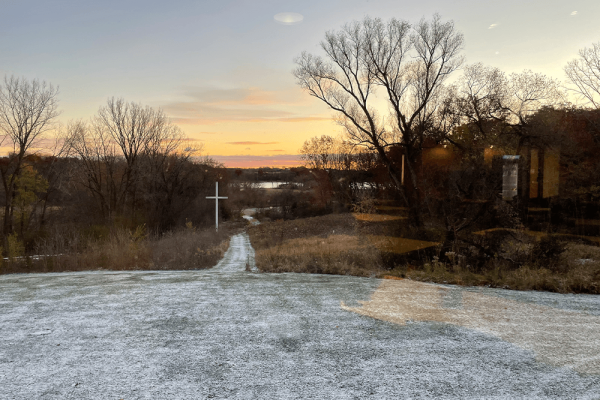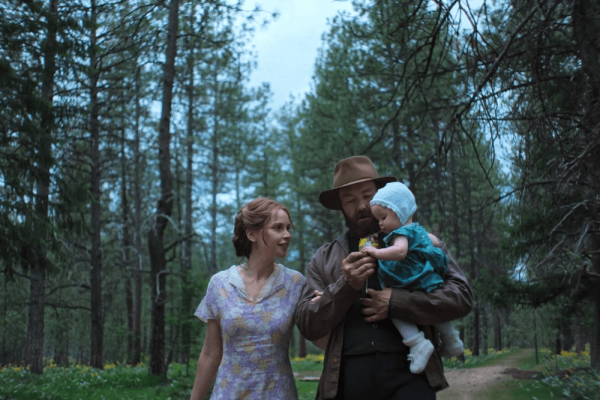THERE IS MUCH anticipation in the air. During Advent, we eagerly await the Christ child among us and all the blessings and transformations this infant brings. Our readings during this season remind us of the Christ child’s vision for our world — and of God’s power to upend existing political orders. This is the child whose mother proclaims that he will “cast down the mighty,” “lift up the lowly,” and change the course of history for God’s people. We welcome the arrival of new life in Christ, imbued with hope and reminders that life is never fully defeated by empire’s death-dealing designs.
But this Christ child comes in many guises. This child appears as an unhoused person, a racial other, an incarcerated person, a foreigner. Will we receive every child of God as we receive the Christ child and honor their hopes and full potential? Will we give to all of God’s children the gifts of our time, energy, joy, and relationship so that our communities become hospitable places for the Christ child and every child?
Indian artist Jyoti Sahi has a beautiful painting called “Incarnation within the Anthill.” In the image, Sahi sets a tightly curled Mary and infant Jesus inside a tall insect mound. In some parts of India, these mounds are called the “ears of the earth.” As numerous, tiny, and insignificant as ants may seem, they are sacred and have inherent value, just as the mother and her newborn child have. It requires deep listening to nurture this Christ-consciousness. May the Advent season remind us that every child is sacred and that honoring God’s image in the tiniest ones can bring down empires.
December 1
A Turnaround Moment
Jeremiah 33:14-16; Psalm 25:1-10; 1 Thessalonians 3:9-13; Luke 21:25-36
THERE HAS BEEN so much destruction at the hands of the Babylonian Empire, but the prophet Jeremiah highlights God’s promise to restore the fortunes of the land. God assures the people that the land marked by desolation will brim with new life (33:15-16). All the destruction the people have witnessed will make way for peace. What a relief!
Jeremiah 33 repeatedly uses the words “justice” and “righteousness.” The Hebrew word sedek (“righteousness”) appears in various forms three times in verses 15 and 16. It means acting rightly according to the promises made. When the Lord acts with righteousness, the people are made safe, and salvation is extended to the land. Righteousness also refers to a horizontal relationship among people — not just between individuals and God. People are righteous when they relate to one another justly and acknowledge each one’s humanity. Such righteousness and right relations become the foundation for God’s salvation. In the prophet’s understanding, salvation is no esoteric concept but is rooted in how people conduct themselves in relation to a neighbor. The nation’s salvation is made possible when people foster just relations among each other. This Advent let’s look closely for the tiny green “righteous branch” sprouting up near us.
December 8
No Half Measures
Malachi 3:1-4; Luke 1:68-79; Philippians 1:3-11; Luke 3:1-6
THE BEGINNING OF Luke 3 can seem a little mundane. Why do we want to hear all the details of rulers and their territories before we get to the big announcement of John the Baptist and his ministry? But these are necessary details. John’s call for repentance challenged oppressive structures. As scripture scholar Richard A. Horsley notes, these rulers were responsible for perpetuating the structures that John is challenging. Luke named names! He fixed their place in history alongside their complicity in oppression. Rather than using the details of these rulers to praise them, Luke instead indicted them.
The word of God came to John, who turned his back on empire. And it came to him in the wilderness, away from the halls of power. John’s detachment from power allowed him to hear the message in ways those associated with power could not. Power by domination blinds people’s ability to see new possibilities or accept uncomfortable truths. John’s religious slogan, drawn from Isaiah 40, of “every valley shall be filled,
and every mountain and hill shall be brought low” (Luke 3:5) sounds too ambitious. His vision that “the crooked shall be made straight, and the rough ways shall be made smooth” (verse 5) appears too grandiose. But John’s sermon matched his times. It was a period of extreme political and economic oppression, and John’s message channeled the moral imperative of a major course correction. How often do we settle for only “trimming” the mountains that block justice or ignore “rough ways” because of the demanding work needed to make them smooth?
December 15
Justice Isn’t Abstract
Zephaniah 3:14-20; Isaiah 12:2-6; Philippians 4:4-7; Luke 3:7-18
IN 2020, WEALTHY white parents of students in Howard County, Md. public schools opposed or failed to support a measure to integrate their schools across racial and economic divides. Many of these parents considered themselves progressive on social issues. But when faced with an option to desegregate the schools their children attended, they failed to translate progressive social ideals into a concrete commitment to justice.
Luke 3 mentions many people going to the countryside to participate in John’s movement of baptism. These were wealthy people who professed a commitment to justice and wanted to be part of what John was stirring up. In my imagination, they snapped selfies with John and posted them on Instagram. They wanted to be seen as hanging with the right crowd, wearing the right shirt, and committed to justice.
Rather than give them a “P” for “participation,” John promptly puts them on the spot, asking them to “produce good fruit” of their repentance (verse 9). He makes it clear that repentance and justice are never abstract ideas but should always manifest themselves in concrete actions in one’s own time and place. John invites people to leverage the power they have — big or little — within their own spheres of influence to challenge oppressive structures and transform lived realities for those who are least protected and most vulnerable.
December 22
Hope > Trauma
Micah 5:2-5; Psalm 80:1-7; Hebrews 10:5-10; Luke 1:39-55
“THE VISITATION” IS a wooden and gold sculpture made in Germany in the 1300s, attributed to Master Heinrich of Constance. It depicts Mary and Elizabeth meeting after the Annunciation. The sculpture adds a small but important detail from Master Heinrich’s sacred imagination. Mary places her left hand on Elizabeth’s shoulder. They grasp one another’s right hands. Elizabeth’s left hand is on her heart. The gentle touching radiates care, mutual support, and celebration at this pivotal moment in their lives.
Luke records Elizabeth asking why she was so favored that “the mother of my Lord comes to me?” (Luke 1:43). But, really, to whom else could Mary have gone? Both cousins have just experienced life-altering announcements from angels. Both have overcome initial skepticism to embrace the good news about the arrival of their prophetic children. Given their shared experiences and emotional spaces, only Elizabeth could offer Mary the support she needed. An irony in this story is that these two women, who were at the margins of power and social hierarchy, were the first to believe in the promise of Advent. Their unique vantage points as the oppressed allowed them to see what those close to power could not. Luke’s original text doesn’t say whether it was Mary or Elizabeth who sang the Magnificat. The generational trauma they experienced at the hands of many foreign empires should have made it impossible for them to sing of hope. However, they did not have the luxury of despair. The ambiguity allows us to imagine the two women announcing with one voice the great things God has done for them and celebrating the salvation. Hope was their only tool for transforming generational trauma into generational healing and power.
December 29
Child Prodigies
1 Samuel 2:18-20, 26; Psalm 148; Colossians 3:12-17; Luke 2:41-52
THE 2006 MOVIE Akeelah and the Bee celebrates the determination of an 11-year-old girl from a low-income neighborhood to win the National Spelling Bee. While most other contestants are from privileged backgrounds, Akeela thrives with the support of her community in South Central Los Angeles and despite her parents’ inability to recognize her gifts.
Luke is the only gospel writer to record the story of Mary and Joseph losing Jesus and later finding him in the temple. Luke tracks the boy Jesus’ adventures and prodigious attributes. Such child prodigy stories are commonplace in Hellenistic literature and show up again in extracanonical gospels. Luke’s story highlights everyone’s amazement and wonder listening to Jesus, including teachers who were impressed by his brilliance and intelligence. Luke suggests that even if Jesus’ parents were lost in their anxiety, their nurture of him and the support of their community contributed to his spiritual and intellectual growth. Within the literary context, Luke suggests that Jesus becomes strong and was filled with wisdom because of all the care he received.
Children flourish when they are nurtured well. When properly supported, children can display wisdom and amazing works. We cannot fully celebrate the Christ child’s demonstration of faith and knowledge here if we are watching from the sidelines as countless children in our own time and place fail to thrive or reach their full potential because of social obstacles placed in their path. This season, let’s act on our promise to ensure that every child receives the care and nurture they deserve.

Got something to say about what you're reading? We value your feedback!







